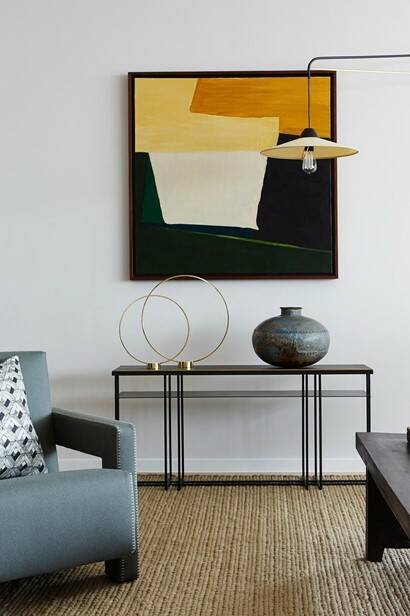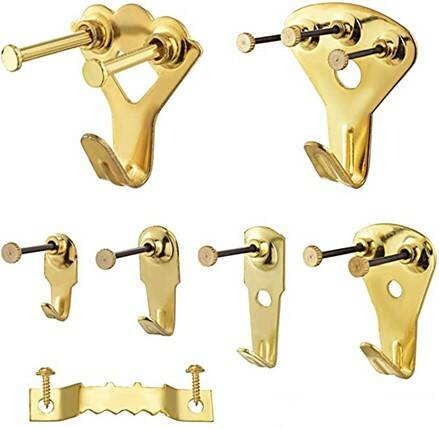- Home
- / Blog
- / Interior Design
Professional Tips On How To Hang A Heavy Picture
01/29/2021
Figuring out how to hang a heavy picture yourself can be a challenge. From the risks of crashing your valuable art pieces to damaging your walls, there are important aspects that you must consider before taking on such a project.

Featured product: Horizon Picture light
Art is an integral part of any décor, and powerful images are showstoppers that upscale any room when properly incorporated. Smaller art pieces are treasures in small homes. However, when it comes to grand halls, luxury hotels, modern offices and other commercial spaces, sometimes bigger has proven to be better. Some of the world’s greatest monumental canvas paintings explored in an article by My Modern Art illustrate just how massive art can be. For very large art work consider a larger picture light - with large artwork everything you choose needs to fit the scale of the work.
Famous framed art pieces with over ten feet in length appropriately exhibited all over the world have stood the test of time, despite their weight. While it is very unlikely that you will ever need to hang a heavy picture of such bulk, there is still a need to understand the various principles applicable for hanging a heavy picture frame or a heavy mirror to your wall.
Main Considerations for Hanging a Heavy Picture
There are various factors considered when deliberating on how to hang a heavy picture, an artwork, or any decorative item with a heavy frame. Multiple methods and art hanging hardware are applicable depending on these aspects. These include the following:
1. Picture Weight
The weight of the artwork is an important factor in the hanging of a picture. This includes the weight of not only the piece itself, but also the picture frame. If you find that you need help mounting the picture on your own, then it would most likely count as a heavy picture.

2016, via Pinterest.
According to WikiHow, artworks can classify as light if they are under ten pounds, medium weight if they range between ten to twenty-five pounds, and heavy if they are over twenty-five pounds.
Take proper caution in the selection of the method and fixing for any picture above that weight. Weigh the picture on a scale before you purchase any fixings to ensure that they can sustain the weight. You can easily do this at home by measuring your weight on the bathroom scale carrying the piece of art and deducting your personal weight without the art. This method will more accurately capture minor weight differences.
2. The Positioning of the Pictures
For the display of any piece of art, the positioning matters, not just for the aesthetics, but also for better preservation. Pictures are better positioned at the eye level, away from any exposure to direct light or heat. This is why the selection of the type of art lighting also matters, especially for valuable art. Consider LED art lighting designs with a variety of options specifically designed to highlight your art without any light or heat damage.
Art makes a statement in a space. Since it mostly acts as a focal point, properly position your pictures away from any obstructions or furniture. Leave an adequate gap between the artwork and the top of the table or chair.

When displaying more than one piece of art, it is important to pay keen attention to the even spacing between the elements, and the orientation of each piece. Aim to achieve a more cohesive presentation for a unified aesthetic through consistent alignment and spacing.
|
Interior shot of a modern house dining room with art on the wall Free Photo, Wirestock, 2020, via Freepik |
3. The Type of Wall
The nature of the wall onto which you will hang the heavy picture is a crucial consideration. It is advisable to hang heavy pictures on load-bearing walls. With some art pieces weighing even over fifty pounds, it is important to ensure that the wall has sufficient structural integrity to sustain the weight of the picture and the picture frame safely. The nature of the wall also dictates the type of fixings used.
Solid masonry brick walls and concrete walls often have adequate load-bearing capacities for heavy art. You can drill or nail them to support the required weight. Where timber panels form the structure of the wall, screws, nails, and picture hooks are applicable.
Read also: How to Hang Pictures on Brick Wall
For drywall or hollow walls, special anchors such as hollow wall anchors can sustain heavier weights. It is critical to either identify the position of the wall stud on the drywall using an electronic stud finder or by knocking onto the surface of the wall and listening for a denser sound. If there are no wall studs, toggle bolt anchors are applicable. Alternatively, you can also use a rail track to hang your picture in this instance. Works best with spotlighting.
4. The Picture Size and Hanging Points
|
Starbucks Regina, Angela Bailey, 2019, via Unsplash. |
Apart from the weight of the picture, you must consider the size and dimensions of the art piece. Since it is advisable to position your hanging points at wall studs or on the structural frames, there might be a challenge when you need more than one anchoring point but the picture length does not span across the entire spacing between the two identified wall studs.
In such a case, you may select an appropriate fixing that can sustain the heavy weight into the drywall without a stud, or opt for a single heavy-duty fixing or anchor designed to adequately bear the entire weight of the art.
Having more anchor points allows you to uniformly distribute the weight of the heavy picture across all fixings. This, therefore, enables the use of art hanging hardware that have weight ratings of just a fraction of the weight of the picture.
Use a tape measure to find the dimensions of the art. For one hanging point, measure and mark a point at the center of the art. For two hanging points, mark two points that are equidistant from the center, for a perfect balance.
5. Method of Hanging: Picture Wire or Picture Hook
Decide in advance whether you opt to use a picture wire or a picture hook to hang your picture. When using a picture hanging wire, fix the screw eyes at a position a third from the top of the picture frame. You can then tighten the hanging wire around the screw eyes on the left and right sides of the picture frame. On the other hand, picture hooks simply attach directly to the frame of the picture, allowing for a more steady display.
For a brick clip hanger or to find picture lights for your artwork see Perfect Picture Lights for expert advice.
6. Types of Fixings
|
Picture Framing and Hanging Accessories, The White Frame Company, 2020, via Pinterest |
There are various fixing and fittings commonly used to hang heavy pictures. This is largely influenced by the nature of the wall and the weight of the picture. Some of these include:
- Drilling and Nailing
For solid wall structures & timber frameworks, drilling and nailing are the most widely used methods of hanging artwork Use a hammer drill and masonry drill bit to drill into harder wall surfaces. Decorative picture hanging nails and screws, presentably designed with hooks, provide for easier and faster hanging. - Drilling and Nailing
A picture hanging system is another brilliant way to hang picture frames and any heavy art pieces. A traditional picture hanger can support over fifty pounds depending on the number of nails or screws it uses. - A strap hanger can bear up to fifty pounds when used together with the picture wire to hang a heavy picture. It is also usable in combination with picture hooks.
- On the other hand, a sawtooth hanger can support a hanging picture of up to 250 pounds, making it a top recommendation in this category. This picture hanger often screws to a piece of wood at the back of the picture frame.
|
Professional Photo Frame Picture Hooks, Amazon Fashion, 2020, via Pinterest |
- Wall Anchors
There are different types of wall anchors that you can use to hang your pictures. Each uniquely designed wall anchor serves a different purpose. Therefore, it is essential to select the most suitable anchor for your wall type and picture weight.
For hanging heavier pictures, the plastic winged anchor offers adequate support of up to twenty-five pounds and is therefore applicable. Toggle bolt anchors also support up to fifty pounds of weight, making them some of the most preferred fixings in the heavy picture hanging. - Picture Hook
Where there is a stud, you can use a picture hook to hang heavy pictures. There is a wide range of designs, used to hang heavy pictures when used together with anchors, nails, or screws. The heavy-duty adhesive hook also offers a picture-hanging solution without any damage to the walls or the art.
- Artwork Hanging Strips
To hang your pictures without drilling or nailing into your walls, artwork-hanging strips are the way to go. The heavy-duty adhesive strips can durably hold weights of up to 16 pounds. Attach and firmly press one piece of the strip to the wall, and the other to the picture frame.
Allow the strip on the wall and that on the picture to bond and set separately for as long as indicated in the instructions manual, usually for approximately one hour. Thereafter, press the frame to the wall to allow the strip on the wall and that on the picture frame to stick firmly together.
|
The One Riverside Park, Decoist.com, 2014, via Pinterest |
|
Large Paintings Need Great Lighting! We recommend lighting almost all the way across larger works of art -  |
In Conclusion
There are many possible ways of hanging heavy art, regardless of size or weight. Considering all the aspects involved allows you to make concrete decisions on the most suitable method and fixings for durable hanging. Apply the above tips and hang your heavy pictures right on the very first try.
_______________________________________________________________________________________________________
Winny Okoth is a practicing Construction Project Manager and Interior Designer. She is also currently pursuing her Master’s Degree in Construction Project Management. Winny Okoth has a great passion for every form of design and has the mastery of principles of design, as well as 3D visualizations skills for architectural and interior design renders.







